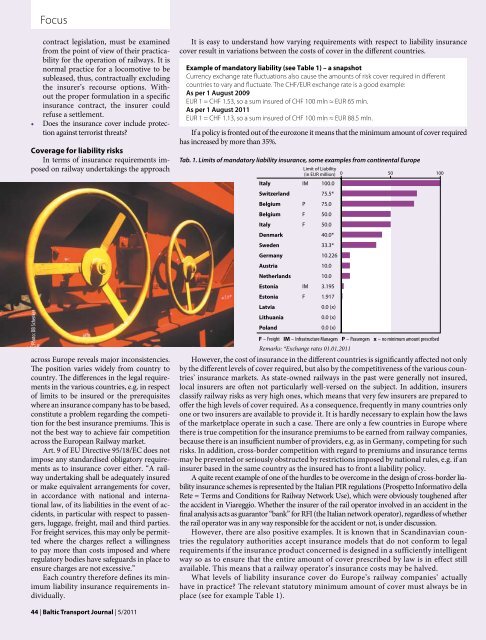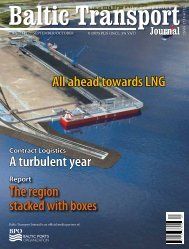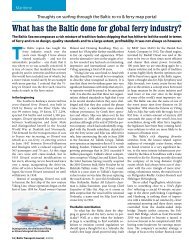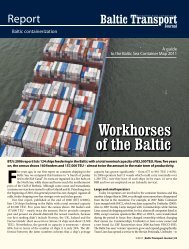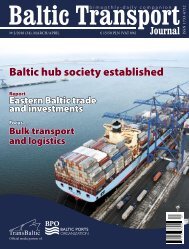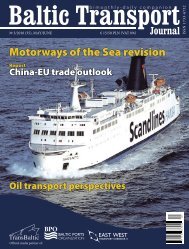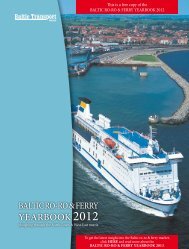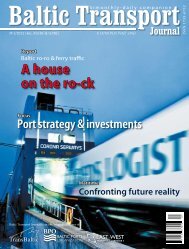BTJ 5/2011 - Baltic Press
BTJ 5/2011 - Baltic Press
BTJ 5/2011 - Baltic Press
- No tags were found...
You also want an ePaper? Increase the reach of your titles
YUMPU automatically turns print PDFs into web optimized ePapers that Google loves.
Focuscontract legislation, must be examinedfrom the point of view of their practicabilityfor the operation of railways. It isnormal practice for a locomotive to besubleased, thus, contractually excludingthe insurer’s recourse options. Withoutthe proper formulation in a specificinsurance contract, the insurer couldrefuse a settlement.• Does the insurance cover include protectionagainst terrorist threats?Coverage for liability risksIn terms of insurance requirements imposedon railway undertakings the approachIt is easy to understand how varying requirements with respect to liability insurancecover result in variations between the costs of cover in the different countries.Example of mandatory liability (see Table 1) – a snapshotCurrency exchange rate fluctuations also cause the amounts of risk cover required in differentcountries to vary and fluctuate. The CHF/EUR exchange rate is a good example:As per 1 August 2009EUR 1 = CHF 1.53, so a sum insured of CHF 100 mln ≈ EUR 65 mln.As per 1 August <strong>2011</strong>EUR 1 = CHF 1.13, so a sum insured of CHF 100 mln ≈ EUR 88.5 mln.If a policy is fronted out of the eurozone it means that the minimum amount of cover requiredhas increased by more than 35%.Tab. 1. Limits of mandatory liability insurance, some examples from continental EuropePhoto: DB Schenkeracross Europe reveals major inconsistencies.The position varies widely from country tocountry. The differences in the legal requirementsin the various countries, e.g. in respectof limits to be insured or the prerequisiteswhere an insurance company has to be based,constitute a problem regarding the competitionfor the best insurance premiums. This isnot the best way to achieve fair competitionacross the European Railway market.Art. 9 of EU Directive 95/18/EC does notimpose any standardised obligatory requirementsas to insurance cover either. “A railwayundertaking shall be adequately insuredor make equivalent arrangements for cover,in accordance with national and internationallaw, of its liabilities in the event of accidents,in particular with respect to passengers,luggage, freight, mail and third parties.For freight services, this may only be permittedwhere the charges reflect a willingnessto pay more than costs imposed and whereregulatory bodies have safeguards in place toensure charges are not excessive.”Each country therefore defines its minimumliability insurance requirements individually.Remarks: *Exchange rates 01.01.<strong>2011</strong>However, the cost of insurance in the different countries is significantly affected not onlyby the different levels of cover required, but also by the competitiveness of the various countries’insurance markets. As state-owned railways in the past were generally not insured,local insurers are often not particularly well-versed on the subject. In addition, insurersclassify railway risks as very high ones, which means that very few insurers are prepared tooffer the high levels of cover required. As a consequence, frequently in many countries onlyone or two insurers are available to provide it. It is hardly necessary to explain how the lawsof the marketplace operate in such a case. There are only a few countries in Europe wherethere is true competition for the insurance premiums to be earned from railway companies,because there is an insufficient number of providers, e.g. as in Germany, competing for suchrisks. In addition, cross-border competition with regard to premiums and insurance termsmay be prevented or seriously obstructed by restrictions imposed by national rules, e.g. if aninsurer based in the same country as the insured has to front a liability policy.A quite recent example of one of the hurdles to be overcome in the design of cross-border liabilityinsurance schemes is represented by the Italian PIR regulations (Prospetto Informativo dellaRete = Terms and Conditions for Railway Network Use), which were obviously toughened afterthe accident in Viareggio. Whether the insurer of the rail operator involved in an accident in thefinal analysis acts as guarantor “bank” for RFI (the Italian network operator), regardless of whetherthe rail operator was in any way responsible for the accident or not, is under discussion.However, there are also positive examples. It is known that in Scandinavian countriesthe regulatory authorities accept insurance models that do not conform to legalrequirements if the insurance product concerned is designed in a sufficiently intelligentway so as to ensure that the entire amount of cover prescribed by law is in effect stillavailable. This means that a railway operator’s insurance costs may be halved.What levels of liability insurance cover do Europe’s railway companies’ actuallyhave in practice? The relevant statutory minimum amount of cover must always be inplace (see for example Table 1).44 | <strong>Baltic</strong> Transport Journal | 5/<strong>2011</strong>


